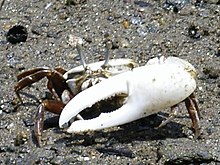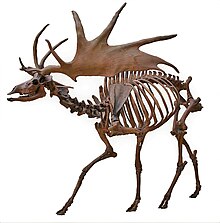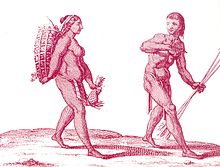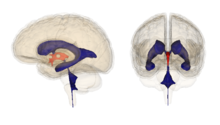Signals are given in contexts such as mate selection by females, which subjects the advertising males' signals to selective pressure. Signals thus evolve because they modify the behaviour of the receiver to benefit the signaller. Signals may be honest, conveying information which usefully increases the fitness of the receiver, or dishonest. An individual can cheat by giving a dishonest signal, which might briefly benefit that signaller, at the risk of undermining the signalling system for the whole population.
The question of whether selection of signals works at the level of the individual organism or gene, or at the level of the group, has been debated by biologists such as Richard Dawkins, arguing that individuals evolve to signal and to receive signals better, including resisting manipulation. Amotz Zahavi suggested that cheating could be controlled by the handicap principle, where the best horse in a handicap race is the one carrying the largest handicap weight. According to Zahavi's theory, signallers such as male peacocks have 'tails' that are genuinely handicaps, being costly to produce. The system is evolutionarily stable as the large showy tails are honest signals. Biologists have attempted to verify the handicap principle, but with inconsistent results. The mathematical biologist Ronald Fisher analysed the contribution that having two copies of each gene (diploidy) would make to honest signalling, demonstrating that a runaway effect could occur in sexual selection. The evolutionary equilibrium depends sensitively on the balance of costs and benefits.
The same mechanisms can be expected in humans, where researchers have studied behaviours including risk taking by young men, hunting of large game animals, and costly religious rituals, finding that these appear to qualify as costly honest signals.
Sexual selection
When animals choose mates, traits such as signalling are subject to evolutionary pressure. For example, the male gray tree frog, Hyla versicolor, produces a call to attract females. Once a female chooses a mate, this selects for a specific style of male calling, thus propagating a specific signalling ability. The signal can be the call itself, the intensity of a call, its variation style, its repetition rate, and so on. Various hypotheses seek to explain why females would select for one call over the other. The sensory exploitation hypothesis proposes that pre-existing preferences in female receivers can drive the evolution of signal innovation in male senders, in a similar way to the hidden preference hypothesis which proposes that successful calls are better able to match some 'hidden preference' in the female. Signallers have sometimes evolved multiple sexual ornaments, and receivers have sometimes evolved multiple trait preferences.Honest signals
Eurasian jay, Garrulus glandarius, gives honest signals—loud alarm calls—from its tree perch when it sees a predator.
Signalling systems are shaped by mutual interests between signallers and receivers. An alert bird such as a Eurasian jay warning off a stalking predator is communicating something useful to the predator: that it has been detected by the prey; it might as well quit wasting its time stalking this alerted prey, which it is unlikely to catch. When the predator gives up, the signaller can get back to other tasks such as feeding. Once the stalking predator is detected, the signalling prey and receiving predator thus have a mutual interest in terminating the hunt.
Within species, mutual interests increase with kinship. Kinship is central to models of signalling between relatives, for instance when broods of nestling birds beg and compete for food from their parents.
The yellow-banded poison dart frog gives an honest signal of its toxicity to warn off predators and reduce the frog's risk of injury.
The term honesty in animal communication is controversial because in non-technical usage it implies intent, to discriminate deception from honesty in human interactions. However, biologists use the phrase "honest signals" in a direct, statistical sense. Biological signals, like warning calls or resplendent tail feathers, are honest if they truly convey useful information to the receiver. That is, the signal trait conveys to the receiver the presence of an otherwise unobservable factor. Honest biological signals do not need to be perfectly informative, reducing uncertainty to zero; all they need to be useful is to be correct "on average", so that certain behavioural responses to the signal are advantageous, statistically, compared to the behaviour that would occur in absence of the signal. Ultimately the value of the signalled information depends on the extent to which it allows the receiver to increase its fitness. Hence, "honest" signals are evolutionarily stable.
One class of honest signal is the aposematic warning signal, generally visual, given by poisonous or dangerous animals such as wasps, poison dart frogs, and pufferfish. Warning signals are honest indications of noxious prey, because conspicuousness evolves in tandem with noxiousness. Thus, the brighter and more conspicuous the organism, the more toxic it usually is. The most common and effective colours are red, yellow, black and white.
Dishonest signals
Male fiddler crab signals with its enlarged fighting claw, but weak regrown claws may be dishonest signals.
Because there are both mutual and conflicting interests in most animal signalling systems, a central problem in signalling theory is dishonesty or cheating. For example, if foraging birds are safer when they give a warning call, cheats could give false alarms at random, just in case a predator is nearby. But too much cheating could cause the signalling system to collapse. Every dishonest signal weakens the integrity of the signalling system, and so reduces the fitness of the group. An example of dishonest signalling comes from Fiddler crabs such as Uca lactea mjoebergi, which have been shown to bluff (no conscious intention being implied) about their fighting ability. When a claw is lost, a crab occasionally regrows a weaker claw that nevertheless intimidates crabs with smaller but stronger claws. The proportion of dishonest signals is low enough for it not to be worthwhile for crabs to test the honesty of every signal through combat.
Richard Dawkins and John Krebs in 1978 considered whether individuals of the same species would act as if attempting to deceive each other. They applied a "selfish gene" view of evolution to animals' threat displays to see if it would be in their genes' interests to give dishonest signals. They criticised previous ethologists, such as Nikolaas Tinbergen and Desmond Morris for suggesting that such displays were "for the good of the species". They argued that such communication ought to be viewed as an evolutionary arms race in which signallers evolve to become better at manipulating receivers, while receivers evolve to become more resistant to manipulation. The game theoretical model of the war of attrition similarly suggests that threat displays ought not to convey any reliable information about intentions.
Sports handicapping metaphor
The best horses in a handicap race carry the largest weights, so the size of the handicap is a measure of the animal's quality.
In 1975, Amotz Zahavi proposed a verbal model for how signal costs could constrain cheating and stabilize an "honest" correlation between observed signals and unobservable qualities, based on an analogy to sports handicapping systems. He called this idea the handicap principle. The purpose of a sports handicapping system is to reduce disparities in performance, making the contest more competitive. In a handicap race, intrinsically faster horses are given heavier weights to carry under their saddles. Similarly, in amateur golf, better golfers have fewer strokes subtracted from their raw scores. This creates correlations between the handicap and unhandicapped performance, and if the handicaps work as they are supposed to, between the handicap and handicapped performance. If you knew nothing about two race horses or two amateur golfers except their handicaps, you could infer which is most likely to win: the horse with the bigger weight handicap, and the golfer with the smaller stroke handicap. By analogy, if peacock 'tails' (large tail covert feathers) act as a handicapping system, and a peahen knew nothing about two peacocks but the sizes of their tails, she could "infer" that the peacock with the bigger tail has greater unobservable intrinsic quality. Display costs can include extrinsic social costs, in the form of testing and punishment by rivals, as well as intrinsic production costs. Another example given in textbooks is the extinct Irish elk, Megaloceros giganteus. The male Irish elk's enormous antlers could perhaps have evolved as displays of ability to overcome handicap, though biologists point out that if the handicap is inherited, its genes ought to be selected against.
The essential idea here is intuitive and probably qualifies as folk wisdom. It was articulated by Kurt Vonnegut in his 1961 short story Harrison Bergeron. In Vonnegut’s futuristic dystopia, the Handicapper General uses a variety of handicapping mechanisms to reduce inequalities in performance. A spectator at a ballet comments: "it was easy to see that she was the strongest and most graceful of all dancers, for her handicap bags were as big as those worn by two hundred pound men." Zahavi interpreted this analogy to mean that higher quality peacocks with bigger tails are signalling their ability to "waste" more of some resource by trading it off for a bigger tail. This resonates with Thorstein Veblen's idea that conspicuous consumption and extravagant status symbols can signal wealth.
The enormous antlers of the extinct Irish elk, Megaloceros giganteus may have evolved as displays of ability to overcome handicap.
Zahavi’s conclusions rest on his verbal interpretation of a metaphor, and initially the handicap principle was not well received by evolutionary biologists. However, in 1984, Nur and Hasson used life history theory to show how differences in signalling costs, in the form of survival-reproduction tradeoffs, could stabilize a signalling system roughly as Zahavi imagined. Genetic models also suggested this was possible. In 1990 Alan Grafen showed that a handicap-like signalling system was evolutionarily stable if higher quality signallers paid lower marginal survival costs for their signals.
In 1982, W.D. Hamilton proposed a specific but widely applicable handicap mechanism, parasite-mediated sexual selection. He argued that in the never-ending co-evolutionary race between hosts and their parasites, sexually selected signals indicate health. This idea was tested in 1994 in barn swallows, a species where males have long tail streamers. Møller found that the males with longer tails, and their offspring, did have fewer bloodsucking mites, whereas fostered young did not. The effect was therefore genetic, confirming Hamilton's theory.
Another example is Lozano's hypothesis that carotenoids have dual but mutually incompatible roles in immune function and signalling. Given that animals cannot synthesize carotenoids de novo, these must be obtained from food. The hypothesis states that animals with carotenoid-depended sexual signals are demonstrating their ability to "waste" carotenoids on sexual signals at the expense of their immune system.
The handicap principle has proven hard to test empirically, partly because of inconsistent interpretations of Zahavi’s metaphor and Grafen’s marginal fitness model, and partly because of conflicting empirical results: in some studies individuals with bigger signals seem to pay higher costs, in other studies they seem to be paying lower costs. A possible explanation for the inconsistent empirical results is given in a series of papers by Getty, who shows that Grafen’s proof of the handicap principle is based on the critical simplifying assumption that signallers trade off costs for benefits in an additive fashion, the way humans invest money to increase income in the same currency. But the assumption that costs and benefits trade off in an additive fashion is true only on a logarithmic scale; for the survival cost – reproduction benefit tradeoff is assumed to mediate the evolution of sexually selected signals. Fitness depends on producing offspring, which is a multiplicative function of reproductive success given an individual is still alive times the probability of still being alive, given investment in signals.
Costly signalling and Fisherian diploid dynamics
The effort to discover how costs can constrain an "honest" correlation between observable signals and unobservable qualities within signallers is built on strategic models of signalling games, with many simplifying assumptions. These models are most often applied to sexually selected signalling in diploid animals, but they rarely incorporate a fact about diploid sexual reproduction noted by the mathematical biologist Ronald Fisher in the early 20th century: if there are "preference genes" correlated with choosiness in females as well as "signal genes" correlated with display traits in males, choosier females should tend to mate with showier males. Over generations, showier sons should also carry genes associated with choosier daughters, and choosier daughters should also carry genes associated with showier sons. This can cause the evolutionary dynamic known as Fisherian runaway, in which males become ever showier. Russell Lande explored this with a quantitative genetic model, showing that Fisherian diploid dynamics are sensitive to signalling and search costs. Other models incorporate both costly signalling and Fisherian runaway. These models show that if fitness depends on both survival and reproduction, having sexy sons and choosy daughters (in the stereotypical model) can be adaptive, increasing fitness just as much as having healthy sons and daughters.Examples
One theory is that autumnal colours are a signal from trees to aphids of powerful chemical defences.
Sam Brown and W. D. Hamilton and Marco Archetti proposed that autumn leaf colour is a signal from trees to aphids and other pest species that migrate in autumn to the trees. In their theory, bright autumn coloration with pinks and yellows is costly to trees because pigments require energy to synthesize, but the investment may help them to reduce their parasite load.
Stotting, for example in Thomson's Gazelle, is cited as an example of signalling: the gazelles jump close to a predator instead of escaping, in what could be a signal of strength.
Human honest signals
Human behaviour may also provide examples of costly signals. In general, these signals provide information about a person’s phenotypic quality or cooperative tendencies. Evidence for costly signalling has been found in many areas of human interaction including risk taking, hunting, and religion.Costly signalling in hunting
A male hunter and a female gatherer of the Kali'na people of Guyana, drawn by Pierre Barrère in 1743. Generous sharing by male hunters may serve as a "costly signal", helping them to acquire mates.
Large game hunting has been studied extensively as a signal of men’s willingness to take physical risks, as well as showcase strength and coordination. Costly signalling theory is a useful tool for understanding food sharing among hunter gatherers because it can be applied to situations in which delayed reciprocity is not a viable explanation. Instances that are particularly inconsistent with the delayed reciprocity hypothesis are those in which a hunter shares his kill indiscriminately with all members of a large group. In these situations, the individuals sharing meat have no control over whether or not their generosity will be reciprocated, and free riding becomes an attractive strategy for those receiving meat. Free riders are people who reap the benefits of group-living without contributing to its maintenance. Fortunately, costly signalling theory can fill some of the gaps left by the delayed reciprocity hypothesis. Hawkes has suggested that men target large game and publicly share meat to draw social attention or to show off. Such display and the resulting favorable attention can improve a hunter’s reputation by providing information about his phenotypic quality. High quality signallers are more successful in acquiring mates and allies. Thus, costly signalling theory can explain apparently wasteful and altruistic behaviour.
In order to be effective, costly signals must fulfill specific criteria. Firstly, signallers must incur different levels of cost and benefit for signalling behaviour. Secondly, costs and benefits must reflect the signallers’ phenotypic quality. Thirdly, the information provided by a signal should be directed at and accessible to an audience. A receiver can be anyone who stands to benefit from information the signaller is sending, such as potential mates, allies, or competitors. Honesty is guaranteed when only individuals of high quality can pay the (high) costs of signalling. Hence, costly signals make it impossible for low-quality individuals to fake a signal and fool a receiver.
Bliege Bird et al. observed turtle hunting and spear fishing patterns in a Meriam community in the Torres Strait of Australia, publishing their findings in 2001. Here, only some Meriam men were able to accumulate high caloric gains for the amount of time spent turtle hunting or spear fishing (reaching a threshold measured in kcal/h). Since a daily catch of fish is carried home by hand and turtles are frequently served at large feasts, members of the community know which men most reliably brought them turtle meat and fish. Thus, turtle hunting qualifies as a costly signal. Furthermore, turtle hunting and spear fishing are actually less productive (in kcal/h) than foraging for shellfish, where success depends only on the amount of time dedicated to searching, so shellfish foraging is a poor signal of skill or strength. This suggests that energetic gains are not the primary reason men take part in turtle hunting and spear fishing. A follow-up study found that successful Meriam hunters do experience greater social benefits and reproductive success than less skilled hunters.
The Hadza people of Tanzania also share food, possibly to gain in reputation. Hunters cannot be sharing meat mainly to provision their families or to gain reciprocal benefits, as teenage boys often give away their meat even though they do not yet have wives or children, so costly signalling of their qualities is the likely explanation. These qualities include good eyesight, coordination, strength, knowledge, endurance, or bravery. Hadza hunters more often pair with highly fertile, hard-working wives than non-hunters. A woman benefits from mating with a man who possesses such qualities as her children will most likely inherit qualities that increase fitness and survivorship. She may also benefit from her husband’s high social status. Thus, hunting is an honest and costly signal of phenotypic quality.
Among the men of Ifaluk atoll, costly signalling theory can also explain why men torch fish. Torch fishing is a ritualized method of fishing on Ifaluk whereby men use torches made from dried coconut fronds to catch large dog-toothed tuna. Preparation for torch fishing requires significant time investments and involves a great deal of organization. Due to the time and energetic costs of preparation, torch fishing results in net caloric losses for fishers. Therefore, torch fishing is a handicap that serves to signal men’s productivity. Torch fishing is the most advertised fishing occupation on Ifaluk. Women and others usually spend time observing the canoes as they sail beyond the reef. Also, local rituals help to broadcast information about which fishers are successful and enhance fishers’ reputations during the torch fishing season. Several ritual behavioural and dietary constraints clearly distinguish torch fishers from other men. First, males are only permitted to torch fish if they participated on the first day of the fishing season. The community is well informed as to who participates on this day, and can easily identify the torch fishers. Second, torch fishers receive all of their meals at the canoe house and are prohibited from eating certain foods. People frequently discuss the qualities of torch fishermen. On Ifaluk, women claim that they are looking for hard-working mates. With the distinct sexual division of labor on Ifaluk, industriousness is a highly valued characteristic in males. Torch fishing thus provides women with reliable information on the work ethic of prospective mates, which makes it an honest costly signal.
In many human cases, a strong reputation built through costly signalling enhances a man’s social status over the statuses of men who signal less successfully. Among northern Kalahari foraging groups, traditional hunters usually capture a maximum of two or three antelopes per year. It was said of a particularly successful hunter:
- "It was said of him that he never returned from a hunt without having killed at least a wildebeest, if not something larger. Hence the people connected with him ate a great deal of meat and his popularity grew."
Physical risks as a costly signal
Young men may take part in risky sports like motorcycle racing to signal their strength and skill.
Costly signalling can be applied to situations involving physical strain and risk of physical injury or death. Research on physical risk taking is important because information regarding why people, especially young men, take part in high risk activities can help in the development of prevention programs. Reckless driving is a lethal problem among young men in western societies. A male who takes a physical risk is sending the message that he has enough strength and skill to survive extremely dangerous activities. This signal is directed at peers and potential mates. When those peers are criminals or gang members, sociologists Diego Gambetta and James Densley find that risk-taking signals can help expedite acceptance into the group.
In a study of risk taking, some types of risk, such as physical or heroic risk for others' benefit, are viewed more favorably than other types of risk, such as taking drugs. Males and females valued different degrees of heroic risk for mates and same-sex friends. Males valued heroic risk taking by male friends, but preferred less of it in female mates. Females valued heroic risk taking in male mates and less of it in female friends. Females may be attracted to males inclined to physically defend them and their children. Males may prefer heroic risk taking by male friends as they could be good allies.
In western societies, voluntary blood donation is a common, yet less extreme, form of risk taking. Costs associated with these donations include pain and risk of infection. If blood donation is an opportunity to send costly signals, then donors will be perceived by others as generous and physically healthy. In a survey, both donors and non-donors expressed perceptions of the health, generosity, and ability of blood donors to operate in stressful situations.
Religion as a costly signal
Religious rituals such as snake handling may be explainable as costly signals.
Costly religious rituals such as male circumcision, food and water deprivation, and snake handling look paradoxical in evolutionary terms. Devout religious beliefs wherein such traditions are practiced therefore appear maladaptive. Religion may have arisen to increase and maintain intragroup cooperation. Cooperation leads to altruistic behaviour, and costly signalling could explain this. All religions may involve costly and elaborate rituals, performed publicly, to demonstrate loyalty to the religious group. In this way, group members increase their allegiance to the group by signalling their investment in group interests. However, as group size increases among humans, the threat of free riders grows. Costly signalling theory accounts for this by proposing that these religious rituals are costly enough to deter free riders.
Irons proposed that costly signalling theory could explain costly religious behaviour. He argued that hard-to-fake religious displays enhanced trust and solidarity in a community, producing emotional and economic benefits. He showed that display signals among the Yomut Turkmen of northern Iran helped to secure trade agreements. These "ostentatious" displays signalled commitment to Islam to strangers and group members. Sosis demonstrated that people in religious communities are four times more likely to live longer than their secular counterparts, and that these longer lifespans were positively correlated with the number of costly requirements demanded from religious community members. However, confounding variables may not have been excluded. Wood found that religion offers a subjective feeling of well-being within a community, where costly signalling protects against free riders and helps to build self-control among committed members. Iannaccone studied the effects of costly signals on religious communities. In a self-reported survey, as the strictness of a church increased, the attendance and contributions to that church increased proportionally. In effect, people were more willing to participate in a church that has more stringent demands on its members. Despite this observation, costly donations and acts conducted in a religious context does not itself establish that membership in these clubs is actually worth the entry costs imposed.
Despite the experimental support for this hypothesis, it remains controversial. A common critique is that devoutness is easy to fake, such as simply by attending a religious service. However, the hypothesis predicts that people are more likely to join and contribute to a religious group when its rituals are costly. Another critique specifically asks: why religion? There is no evolutionary advantage to evolving religion over other signals of commitment such as nationality, as Irons admits. However, the reinforcement of religious rites as well as the intrinsic reward and punishment system found in religion makes it an ideal candidate for increasing intragroup cooperation. Finally, there is insufficient evidence for increase in fitness as a result of religious cooperation. However, Sosis argues for benefits from religion itself, such as increased longevity, improved health, assistance during crises, and greater psychological well being though both the supposed benefits from religion and the costly-signaling mechanism have been contested.












